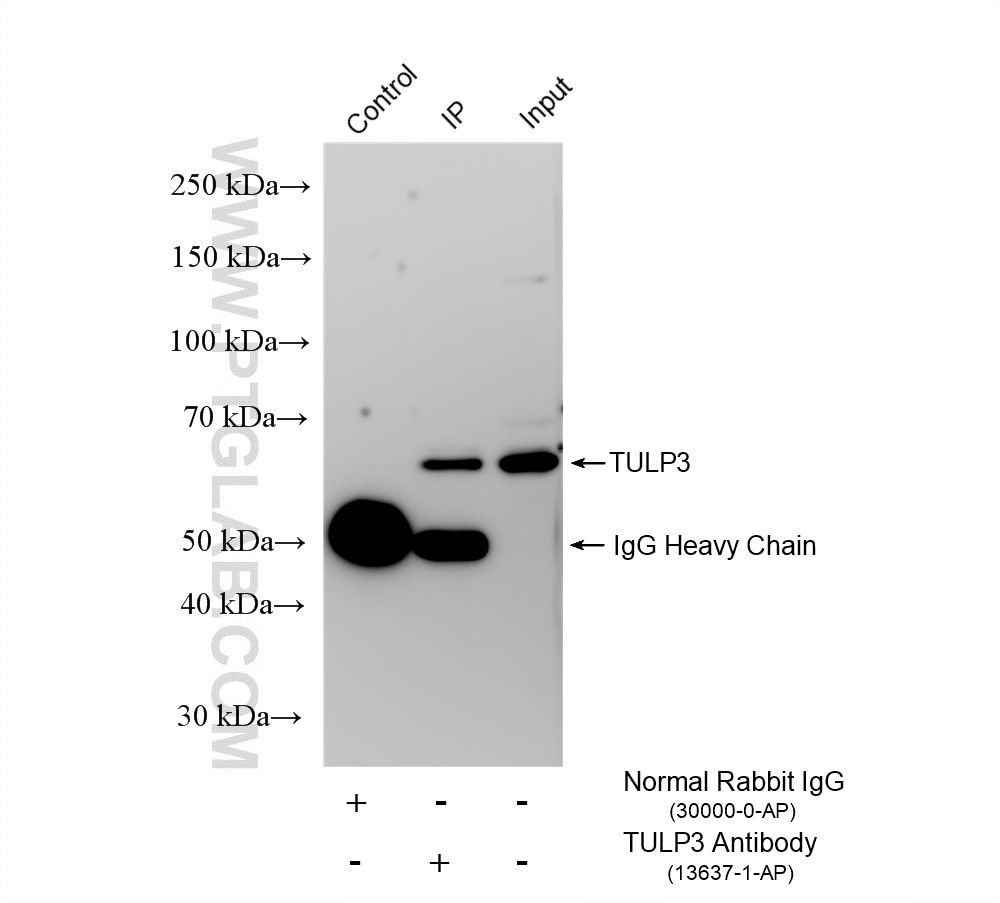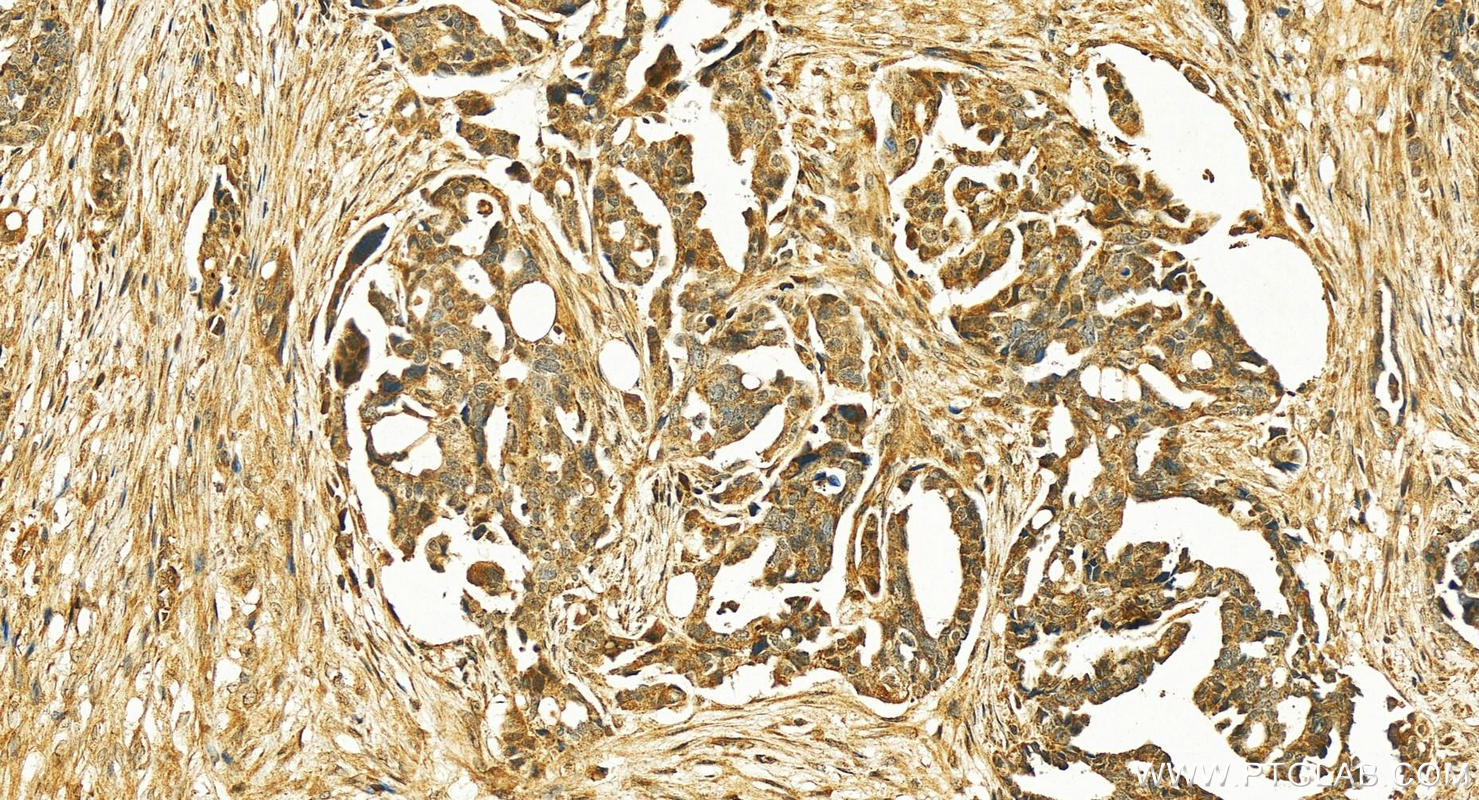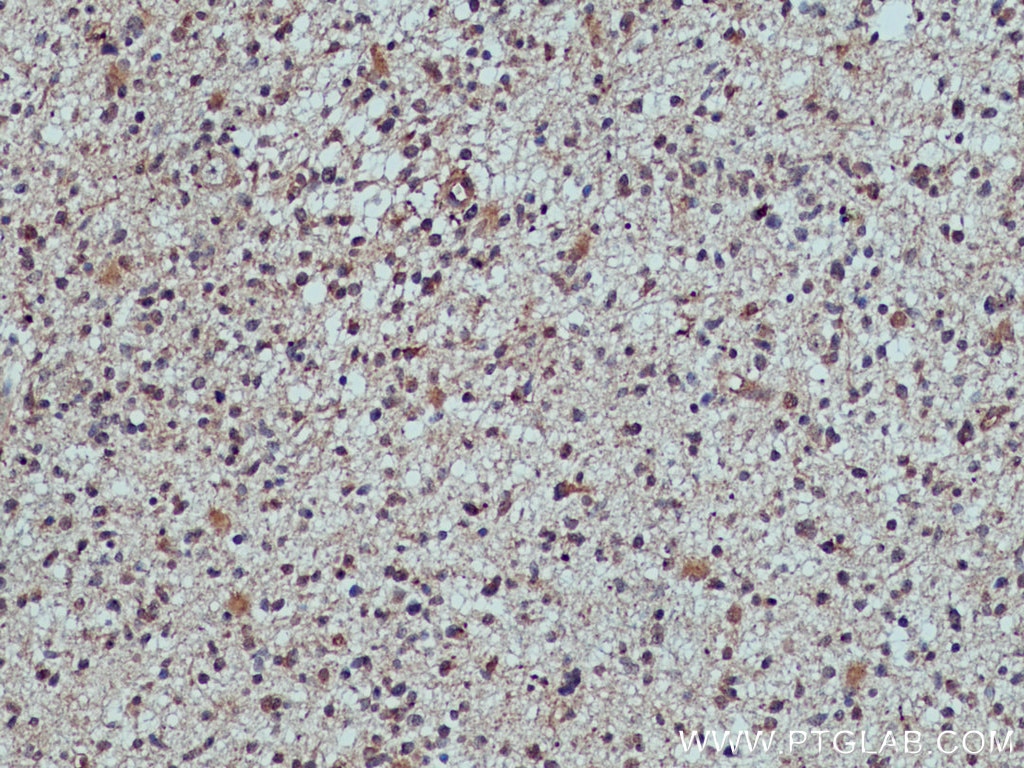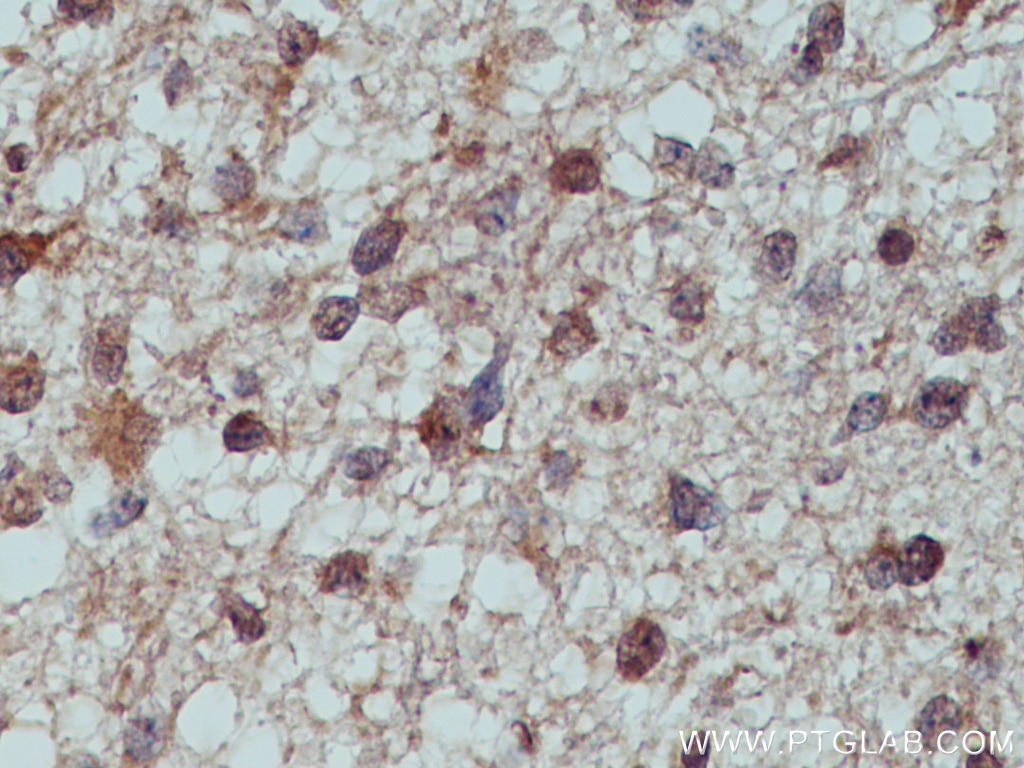- Phare
- Validé par KD/KO
Anticorps Polyclonal de lapin anti-TULP3
TULP3 Polyclonal Antibody for WB, IHC, IP, ELISA
Hôte / Isotype
Lapin / IgG
Réactivité testée
Humain, rat, souris
Applications
WB, IHC, IF, IP, CoIP, ELISA
Conjugaison
Non conjugué
N° de cat : 13637-1-AP
Synonymes
Galerie de données de validation
Applications testées
| Résultats positifs en WB | cellules HEK-293, cellules HeLa, cellules SH-SY5Y |
| Résultats positifs en IP | cellules SH-SY5Y, |
| Résultats positifs en IHC | human ovary cancer tissue, tissu de gliome humain il est suggéré de démasquer l'antigène avec un tampon de TE buffer pH 9.0; (*) À défaut, 'le démasquage de l'antigène peut être 'effectué avec un tampon citrate pH 6,0. |
Dilution recommandée
| Application | Dilution |
|---|---|
| Western Blot (WB) | WB : 1:1000-1:8000 |
| Immunoprécipitation (IP) | IP : 0.5-4.0 ug for 1.0-3.0 mg of total protein lysate |
| Immunohistochimie (IHC) | IHC : 1:50-1:500 |
| It is recommended that this reagent should be titrated in each testing system to obtain optimal results. | |
| Sample-dependent, check data in validation data gallery | |
Applications publiées
| KD/KO | See 4 publications below |
| WB | See 9 publications below |
| IHC | See 1 publications below |
| IF | See 9 publications below |
| CoIP | See 1 publications below |
Informations sur le produit
13637-1-AP cible TULP3 dans les applications de WB, IHC, IF, IP, CoIP, ELISA et montre une réactivité avec des échantillons Humain, rat, souris
| Réactivité | Humain, rat, souris |
| Réactivité citée | Humain, souris |
| Hôte / Isotype | Lapin / IgG |
| Clonalité | Polyclonal |
| Type | Anticorps |
| Immunogène | TULP3 Protéine recombinante Ag4570 |
| Nom complet | tubby like protein 3 |
| Masse moléculaire calculée | 442 aa, 50 kDa |
| Poids moléculaire observé | 60 kDa |
| Numéro d’acquisition GenBank | BC032587 |
| Symbole du gène | TULP3 |
| Identification du gène (NCBI) | 7289 |
| Conjugaison | Non conjugué |
| Forme | Liquide |
| Méthode de purification | Purification par affinité contre l'antigène |
| Tampon de stockage | PBS with 0.02% sodium azide and 50% glycerol |
| Conditions de stockage | Stocker à -20°C. Stable pendant un an après l'expédition. L'aliquotage n'est pas nécessaire pour le stockage à -20oC Les 20ul contiennent 0,1% de BSA. |
Informations générales
The tubby-like protein 3 (TULP3) has been identified as a member of tubby and tubby-like proteins (TULPs) that plays an important role in maintenance and function of neuronal cells during development and post-differentiation. Tulp3 gene is essential for embryonic development in mice. Recently TULP3 has been reported to bind to the IFT (intraflagellar transport)-A complex and promote trafficking of G protein-coupled receptors into primary cilia, which is implicated in regulating neuronal function.
Protocole
| Product Specific Protocols | |
|---|---|
| WB protocol for TULP3 antibody 13637-1-AP | Download protocol |
| IHC protocol for TULP3 antibody 13637-1-AP | Download protocol |
| IP protocol for TULP3 antibody 13637-1-AP | Download protocol |
| Standard Protocols | |
|---|---|
| Click here to view our Standard Protocols |
Publications
| Species | Application | Title |
|---|---|---|
Sci Adv Ciliopathy protein HYLS1 coordinates the biogenesis and signaling of primary cilia by activating the ciliary lipid kinase PIPKIγ. | ||
PLoS Genet Zfp423 Regulates Sonic Hedgehog Signaling via Primary Cilium Function.
| ||
J Neurosci Comparison of ciliary targeting of two rhodopsin-like GPCRs: role of C-terminal localization sequences in relation to cilium type.
| ||
J Biol Chem Deletion of the phosphatase INPP5E in the murine retina impairs photoreceptor axoneme formation and prevents disc morphogenesis. |
Avis
The reviews below have been submitted by verified Proteintech customers who received an incentive for providing their feedback.
FH Evan (Verified Customer) (09-30-2019) | One of the worst antibodies I have ever used. I do not believe this antibody accurately detects Tulp3 by western blotting at all. The amount of non-specific bands at all sizes is so bad this antibody is pretty much only good for a protein stain. I have wasted weeks trying to get this antibody to work to no avail. Avoid this product for western blotting at all costs.
|
FH Francesc (Verified Customer) (09-19-2018) | We previously described that TULP3 (a PIP2-binding protein) accumulates in INPP5E-KO cilia, which also accumulate PIP2 (Garcia-Gonzalo et al. 2015 Dev Cell 34:400-409). We have successfully confirmed those results using Proteintech's anti-TULP3 antibody (13637-1-AP) in both mouse embryonic fibroblasts (MEFs, see my previous review) and in hTERT-RPE1 cells (here). This TULP3 antibody works beautifully, especially in human cells (it also works well in MEFs, but ciliary signal is less intense and lower dilution is needed). As far as I know, this is the best commercial anti-TULP3 available.
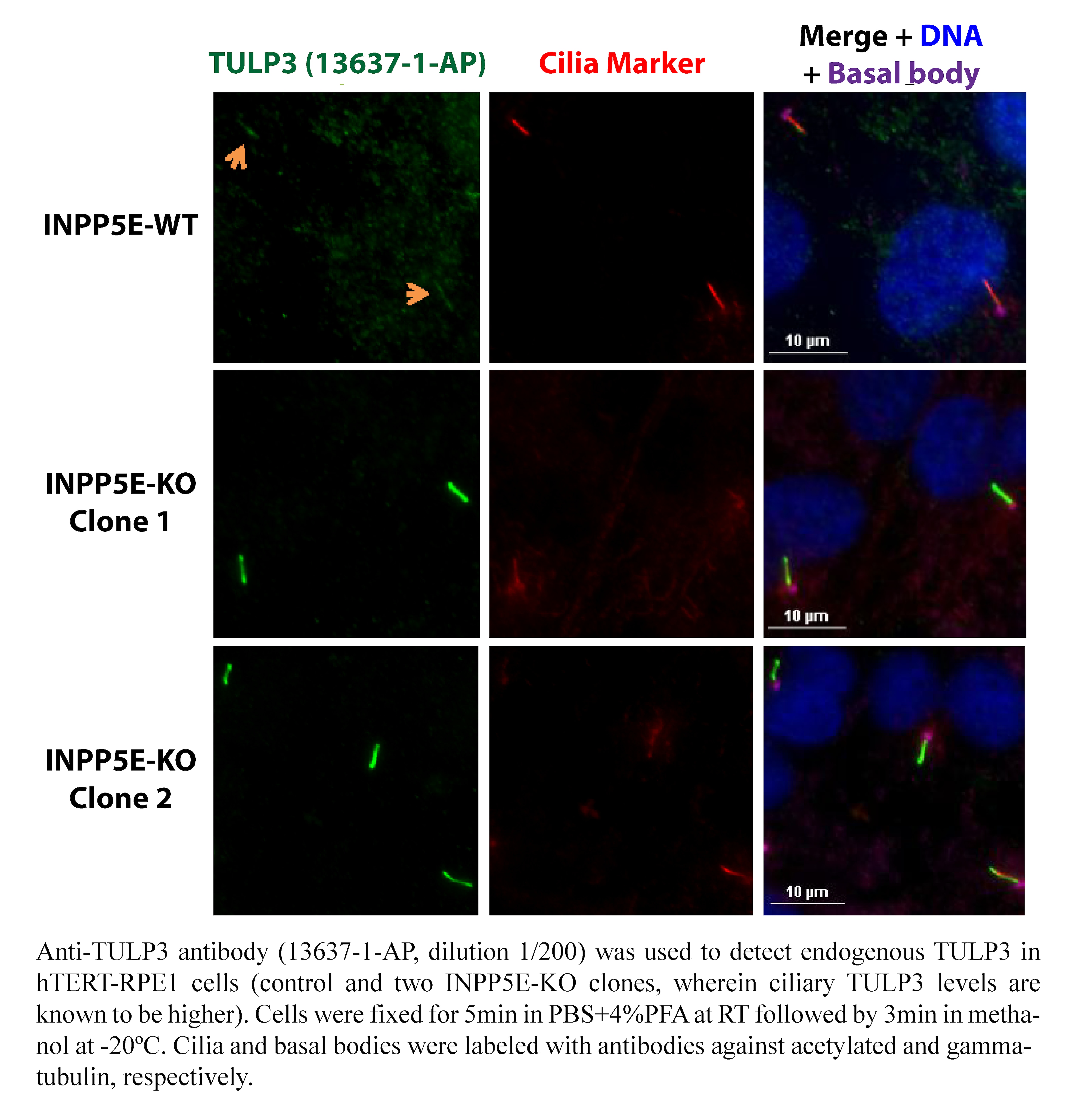 |


